The Many Uses and Products of Coconut
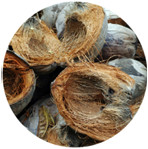 COCONUT PITH
COCONUT PITH
Uses and Products: Pith of stem contains starch that can be extracted and used as flour; pith from top of tree can be pickled in coconut vinegar; can be made as a vegetable roll, lumpia, or native dish, guinataan; guinit that can produce shoe straps, handbags, fans, picture frames, decorative accessories, etc.
 COCONUT HEART
COCONUT HEART
Uses and Products: Fresh juices from the coconut heart can be used to cure fever; can be eaten as a vegetable called ubod; ground coco hearts made into a paste and combined with molasses is said to regulate menstruation when eaten every day.
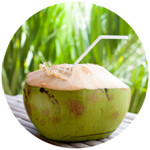 COCONUT TRUNK
COCONUT TRUNK
Uses and Products: Can be made into benches, tables, boxes; lumber can be produced out of the trunk of old, mature trees; dried coconut bark can be used to ignite coals in camphor censers; can be used to make small canoes, rafts, sheds, and other semi-permanent buildings; bottom part of trunk can be used as a drum; ornamental wood carving; paper pulp can be extracted from the trunk and other woody parts of the tree.
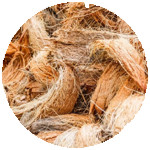 COCONUT SPATHE and GUINIT
COCONUT SPATHE and GUINIT
Uses and Products: Used to make handbags, hats, packaging materials, and baskets.
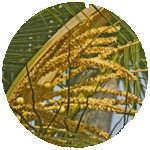 COCONUT INFLORESCENSE
COCONUT INFLORESCENSE
Uses and Products: Tuba, coco sugar, coco nectar syrup, wine, liquor, and vinegar from sap; fruits trays, placemats, artificial flowers, hats, picture frames, blinds, and curtains.
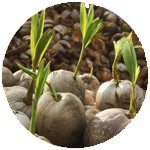 COCONUT SPROUTING SEEDS
COCONUT SPROUTING SEEDS
Uses and Products: May be eaten like celery; seeds are used as a treatment for skin and nasal ulcers.
 COCONUT LEAVES
COCONUT LEAVES
Uses and Products: Used as fuel and as fish bait and source of cheap lime when burnt; produce good quality paper pulp and midrib brooms; provide thatching materials for roofs and matting for floors, walls, and sun shades; the fonds can be woven to make hats, toys, fans, baskets, trays, lamp shades, placemats, bags, clothing, furnishings, screens, wall of make-shift buildings for temporary shelter; wrapper of the palm can be used for toilet paper.
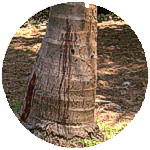 Coconut Stem: Center veins of the frond pinnae can be bunched together to make a good whisk broom or used individually as a toothpick; sections of stem after scooping out pith are used as flumes or gutters for carrying water.
Coconut Stem: Center veins of the frond pinnae can be bunched together to make a good whisk broom or used individually as a toothpick; sections of stem after scooping out pith are used as flumes or gutters for carrying water.
 Coconut Stiff midribs/leaflet midribs: Used to make skewers, arrows, brooms, brushes, fish traps; midribs of leaves are used to make brooms of different types for cleaning rough grounds or floors.
Coconut Stiff midribs/leaflet midribs: Used to make skewers, arrows, brooms, brushes, fish traps; midribs of leaves are used to make brooms of different types for cleaning rough grounds or floors.
 Coconut Leaf fiber: Used to make mats, slippers, bags, and short-lined torches.
Coconut Leaf fiber: Used to make mats, slippers, bags, and short-lined torches.
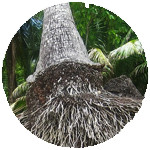 COCONUT ROOTS
COCONUT ROOTS
Uses and Products: Used as toothpaste and mouthwash; dye from boiling the roots; medicine for dysentery; frayed out makes a natural toothbrush; used as a coffee substitute when scorched; used for several ailments, including as infusion for sore throat gargles; believed to be antiblenorrhagic, antibronchitis, febrifugal, and antigingintic; source of tannin; and beverage (root beer).
 FLOWERS OF THE COCONUT FRUIT
FLOWERS OF THE COCONUT FRUIT
Uses and Products: Unopened flowers are protected by sheath, often used for fashion shoes, caps, even a kind of pressed helmet for soldiers; opened flowers provide a good honey for bees; a clump of unopened flowers may be bound together, bent over, and its tip bruised to produce a steady dripping of sweet juice, called sap, up to a gallon per day –which contains 16-30 mg ascorbic acid/100g.
By-products from the sap: sugar, nectar syrup, vinegar, fresh beverage, tuba, lambanog (distilled liquor), beer and wine, champagne,gin; mixed grated coconut to make candy; boiled toddy when mixed with lime makes good cement; and a source of yeast to make breads.
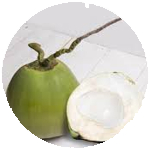 YOUNG COCONUT
YOUNG COCONUT
Uses and Products: If nut is allowed to germinate, cavity fills with a spongy mass called “bread,” which is eaten raw or toasted in shell over fire.
 COCONUT HUSK
COCONUT HUSK
Uses and Products: Tests show that 80% coconut coir and 40% abaca bleached sulfate pulp are a good combination in the production of offset book paper; coir is the fiber from the husk used in ropes, yarns, carpets, rugs, brushes, caulking boats, stuffing fiber, bristles for making potting compost in horticulture, and mulch for plant growing; dried husk makes the best cooking fire for barbeques or plain camp fire cooking; mosquito coil and mosquito smudges; smoke of burning husk is a natural mosquito repellent; dried fibers of the nut can be shredded as stuffing for pillows, mattresses, car seats, upholstery, and life-preservers; for planters, plant holders, and flower pots; for sound proofing and aquarium filters; resin of the inner husk is used for toothache relief; for erosion control, geotextile, and electrical insulators; fiber is resistant to sea water and is used of cable and rigging on ships; and used for olive oil filters in Italy and Greece.
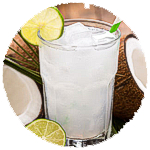 COCONUT WATER
COCONUT WATER
Uses and Products: Drank like a juice; cooked with or mixed with rum for cocktails; vinegar production; used for embryo culture; food jelly and used in the production of the chewy, fiber-rich nata de coco, a dessert and serves as a laxative; yeast and wine by yeast fermentation; alcohol and ethyl acetate; contains growth substances, minerals, and vitamins used for plants as growth enhancer; used for anti-aging skincare products.
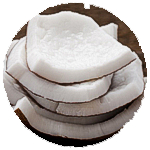 COCONUT MEAT
COCONUT MEAT
Uses and Products: Virgin coconut oil (VCO) is extracted from unrefined, unbleached, and undeodorized coconut meat –VCO is used as a dietary supplement, for skin and body care, and infant formula; source of the refined, bleached, and deodorized oils, which is extracted from the dried meat of the coconut called copra –which is rich in glycerin that is used for cooking, margarine, detergent, candles, shaving cream, toothpaste, lotions, lubricants, hydraulic fluids, synthetic rubber, cosmetics, and bath and laundry soap; remains/waste from copra is made into animal feeds for cattle or poultry (copra meal); oil is used to produce coconut bio-diesel (alternative fuel for engine) and other oleochemicals; for salad, butter, food extenders, medicine, glycerin emulsifiers, anti-pollutant, resins, esters, toothpaste, skin-care, and sodium lauryl sulfate (mild foaming cleansing agent); coconut meat is used to produce flour and desiccated coconut, and is the source of the coconut milk and coconut cream used for cakes, pies, candies, curries, sweets, coffee creamer, and ice cream; coconut meat is used to produce vegetarian butter, cheese, and yoghurt, and can be converted into coco chips, coco jam, and biscuits.
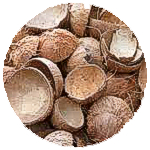 COCONUT SHELL
COCONUT SHELL
Uses and Products: Dried half shells are used to buff floors; useful as microporous filters for aquariums; made into many forms of bowls, cups, ladles, storage containers, placemats, accessory for gifts, decorative accessories, furniture, handbags, and fashion accessories such as earrings, bracelets, necklaces, and buttons; used to make small drums, guitars, and wind chimes; charcoal from shell is used in the production of submarines, cigarette tips, and cooking fires; brunt shells are used for fuel, copra kilns, and charcoal; used to make floor and wall tiles; used to make briquetted charcoal and activated carbon (which can be a domestic filter for drinking water and to remove poison); coconut shell flour used in industry as filler in plastics; used in the production of air purification systems such as cooker hoods, air conditioning, air filters, gas masks, and cabin filters.

